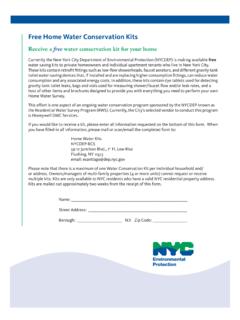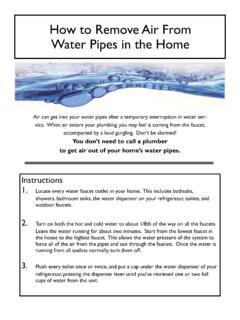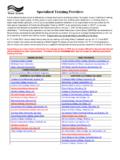Transcription of A Do-It-Yourself Home Water Audit - Welcome to …
1 A Do-It-Yourself home Water AuditThis page is left blank intentionally. Please use the double-sided printer setting when Do-It-Yourself home Water AuditStep 1 Crush Dye Tablets into Toilet TankWater use associated with toilets accounts for 30% of total Water use. Toilets are the highest consumers of Water in most homes. Take the dye tablets out of the kit, crush them and place one into the tank (not the bowl) of each tank-type toilet in the house. Do not flush the toilet during this time. Let it sit for 5-15 minutes until it dissolves into the Water in the tank. If dye appears in the bowl within 30-seconds, it means that you have a serious toilet flapper or refill valve leak.
2 If you see dye within your toilet bowl, please go to the toilet Audit at the end of Step new home Water Savings Kit can help you conduct a Do-It-Yourself Water Audit in less than an hour. Just follow these simple step-by-step instructions on how to find and repair costly leaks. Please note that for the Audit to be successful, you will not be able to use Water for any other purposes until you complete Step 2. Please do not flush any toilets in your home until you have finished Step Dye Tablets into Toilet TanksUsing Your Water Meter as a Leak DetectorCheck your Water Service LineThe Heating SystemThe KitchenThe BathroomInstalling the Water Faucet AeratorChecking for Toilet LeaksReplacing Your ShowerheadLaundry AreaThe Garden Hose12345678 Step 2 Using your Meter as a Leak DetectorNew York City s Water meters are now read remotely and electronically about four times a day.
3 You can track your Water use on DEP s website ( ) by clicking on the My DEP Account and Online Bill Pay button. After registering your account online, you can sign up for DEP s email leak notification program. Reading your Water meter is an easy way to find medium-to-large leaks in your home . Water meters are usually located in the basement. Sometimes, the meter may be in a garage or a pit on the front lawn. If direct light is not available, you may need to bring a flashlight and use caution. Before you check for leaks, be sure to stop using any Water within your residence. Look at the meter dial; you will see a small red arrow, triangle or sweep arm.
4 This small dial, or sweep hand, should be completely still if Water is not being used in your home and there are no leaks. If the sweep hand or red triangle moves while no one is using Water , it means you have a leak. Complete the home Water Audit in just 8 simple steps!A Do-It-Yourself home Water AuditStep 3 Check your Water Service LineThe Water service line is the pipe coming from the street into your home . The valve to shut off Water to your home is located on the service pipe. Once you have located your service line, inspect where it enters the home and check for leaks. A service line with a significant leak may cause puddles in front of your home above the service line and Water in your basement.
5 To check for additional leaks, inspect interior exposed piping for throughout your LineSewer LineDEP Sewer LineStep 4 The Heating SystemInspect your boiler and hot Water heater for leaks by looking for Water accumulating on the floor. Use a thermometer to check the hot Water temperature at the sinks in your home . If the temperature is above 120 degrees, consider reducing the temperature at the hot Water heater. If you do not have a separate hot Water heater, there should be an aqua stat or temperate control on your boiler. This should be set to 120 degrees during the months outside of the heating season (April-October).
6 Speak with a licensed plumber or heating system maintenance contractor if you need technical there is a circulating pump for the boiler, watch the pump and the dial on your Water meter when the heat comes on and the pump runs. In some cases, the pump will leak only when the pump operates. Do you need to add Water to your heating system boiler on a regular basis? If so, you likely have a leak. The leak is significant if Water must be added once a week or 5 The KitchenInspect kitchen faucets and piping for leaks. Be sure to check for leaks with the Water faucet both on and off. Use the shower flow measurement bag in the kit, a measuring cup, or a quart container to measure the flow from the kitchen faucet.
7 A flow of three gallons per minute (gpm) is the same as filling: A quart container in five seconds A four-cup measuring cup in secondsIf the Water flows at more than three gpm, replace the existing faucet aerator and install the kitchen (swivel) aerator that comes with the kit (installation instructions are provided). If your existing aerator or faucet tip cannot be removed, hardware stores carry aerators that clip onto the faucet. If you have a kitchen dishwasher, make sure to inspect it and any surrounding piping for leaks. When you inspect the piping under the sink, be sure to check for leaks when Water is turned both on and buying new appliances, choose an EnergyStar model.
8 These models can be found on EPA s website: Do-It-Yourself home Water AuditStep 6 The BathroomInspect your bathroom faucets and piping for leaks. Check the Water flow from your bathroom faucet just as you did for the kitchen faucet. Bathroom faucets should flow at less than two gallons per minute (gpm). This is the same as filling: A four-cup measuring cup in less than four seconds A one-quart container in less than eight secondsIf your bathroom sink fills these containers faster, you should install the bathroom sink aerators that come with the kit. They will reduce Water flow to less than two gpm. Step 6 AInstalling the Water Faucet AeratorInstalling a new faucet aerator on your sink will save up to two gallons of Water per minute.
9 You will also save energy by reducing the amount of hot Water Remove and discard the old aerator in your metals recycling bin. Clean faucet threads inside and Threaded Faucets: Place washer A on washer B, in top of aerator. Screw aerator into inside threads of Threaded Faucets: Discard washer A. With washer B in top of aerator screw aerator onto outside threads. NOTE: Occasionally remove the aerator and 6 BChecking for Toilet LeaksReturn to the toilets where you deposited dye tablets at the beginning of the Audit . Is the Water in the toilet bowl clear or is there color from the dye? If there is color, Water from the toilet tank is leaking into the toilet bowl.
10 If the leak is large, you will be able to hear the toilet running and the dye will show up in the bowl within a minute or two. The size of the leak is proportional to the speed that the dye shows up in the bowl from the tank. Information about replacing the toilet flapper or refill valve appears in the brochure, Repair Your Leaking Toilets, available on the DEP your toilet is more than 15 years old, fill and install the toilet displacement bag and follow the provided Do-It-Yourself home Water AuditStep 6 CReplacing Your ShowerheadUse the shower flow measurement bag in the kit or a measuring cup to determine the amount of flow from the shower.
















